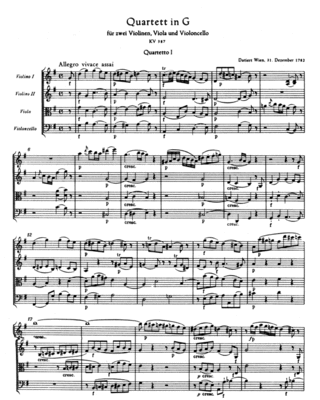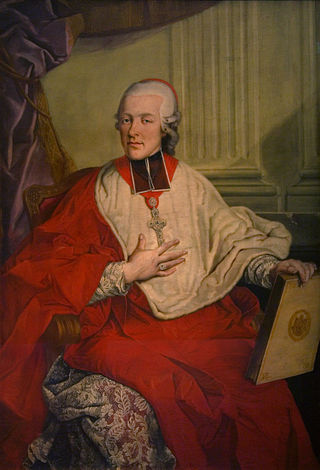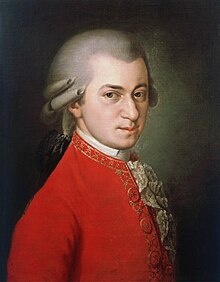
Symphony No. 40 in G minor, K. 550 was written by Wolfgang Amadeus Mozart in 1788. It is sometimes referred to as the "Great G minor symphony", to distinguish it from the "Little G minor symphony", No. 25. The two are the only extant minor key symphonies Mozart wrote.

The String Quartet No. 14 in G major, K. 387, nicknamed the "Spring" quartet, was composed by Wolfgang Amadeus Mozart in 1782 while in Vienna. In the composer's inscription on the title page of the autograph score is stated: "li 31 di decembre 1782 in vienna". The work was perhaps edited in 1783. This is the first of the Haydn Quartets, a set of six string quartets he wrote during his first few years in Vienna and dedicated to Joseph Haydn.

The Symphony No. 31 in D major, K. 297/300a, better known as the Paris Symphony, is one of the most famous symphonies by Wolfgang Amadeus Mozart. It may have been first of his symphonies to be published when Seiber released their edition in 1779.

The Symphony No. 33 in B♭ major, K. 319, was written by Wolfgang Amadeus Mozart, and dated on 9 July 1779.

Symphony No. 14 in A major, K. 114, is a symphony composed by Wolfgang Amadeus Mozart on December 30, 1771, when Mozart was fifteen years old, and a fortnight after the death of the Archbishop Sigismund von Schrattenbach. The piece was written in Salzburg between the composer's second and third trips to Italy. Mozart was also influenced by J. C. Bach's "Italianate" style of composition".

The Piano Concerto No. 16 in D major, K. 451, is a concertante work for piano, or pianoforte, and orchestra by Wolfgang Amadeus Mozart. Mozart composed the concerto for performance at a series of concerts at the Vienna venues of the Trattnerhof and the Burgtheater in the first quarter of 1784, where he was himself the soloist. Mozart noted this concerto as complete on 22 March 1784 in his catalog, and performed the work later that month. Cliff Eisen has postulated that this performance was on 31 March 1784.

The Symphony No. 28 in C major, K. 200/189k, by Wolfgang Amadeus Mozart is his last piece in the "Salzburg series". The date of composition is uncertain; it probably dates from 17 or 12 November 1774 or 1773.

Michael Haydn's Symphony No. 23 in D major, Perger 43, Sherman 22, Sherman-adjusted 23, MH 287, is believed to have been written in Salzburg around 1779. This symphony was incorrectly attributed to Wolfgang Amadeus Mozart by Ludwig von Köchel with the number K. 291, on the basis of a fragment of manuscript which Mozart copied, apparently to help him study the fugue form of the final movement.

The Symphony No. 26 in E♭ major, K. 184/161a, was written by Wolfgang Amadeus Mozart and completed on March 30, 1773, one month after he returned from his third Italian tour.

Symphony No. 9 in C major, K. 73/75a, by Wolfgang Amadeus Mozart, has an uncertain provenance. The most likely date of its composition appears to be late 1769 or early 1770 during Mozart's first Italian journey, although some authorities have dated it "probably not before early summer 1772". It may have been started in Salzburg, before the first Italian journey began, and completed during the trip.

The Symphony No. 15 in G major, K. 124 by Wolfgang Amadeus Mozart was written in Salzburg during the first weeks of 1772. A note on the autograph manuscript indicates that it might have been written for a religious occasion, possibly in honour of the new Archbishop of Salzburg. The work is in four movements, the first of which has been described as innovative and "daring", in view of its variations of tempo. The last movement is characterised by good humour and frivolity, with "enough ending jokes to bring the house down".

Wolfgang Amadeus Mozart wrote Symphony No. 30 in D major, K. 202/186b in Salzburg, completing it on May 5, 1774.

Symphony No. 17 in G major, K. 129, is the second of three symphonies completed by Wolfgang Amadeus Mozart in May 1772, when he was 16 years old, but some of its sections may have been written earlier.

Symphony No. 21 in A major, K. 134, is a symphony that was composed by Wolfgang Amadeus Mozart in August 1772.

The Symphony No. 23 in D major, K. 181/162b, by Wolfgang Amadeus Mozart was dated as complete on May 19, 1773. It is sometimes called "Overture", even though the autograph score bears the title "Sinfonia". The symphony is scored for 2 oboes, 2 horns in D, 2 trumpets in D, and strings.
The Serenade No. 5 in D major, K. 204/213a was written on 5 August 1775 by Wolfgang Amadeus Mozart for ceremonies at the University of Salzburg. The work is very similar to the serenade K. 203, composed for Salzburg the previous summer.

The Serenade No. 4 in D major, K. 203/189b was written in August 1774 by Wolfgang Amadeus Mozart for ceremonies at the University of Salzburg. It is nicknamed Colloredo after Mozart's patron, Count Hieronymus von Colloredo. The work is very similar to the serenade K. 204 composed for Salzburg the following summer.
The Symphony in D major "No. 48", K. 111+120, was composed by Wolfgang Amadeus Mozart in 1771. The first two movements are from the overture to the opera Ascanio in Alba, K. 111, and the last movement, K. 120/111a, was composed separately.
The Symphony in C major "No. 52", K. 208+102, was composed by Wolfgang Amadeus Mozart in 1775. The first two movements are from the opera Il re pastore, K. 208, and the last movement, K. 102/213c, was composed separately. The movements are played one after another without a break.

The Symphony in F major, K. Anh. 223/19a, was written by Wolfgang Amadeus Mozart probably in early 1765 in London.








